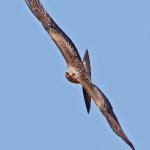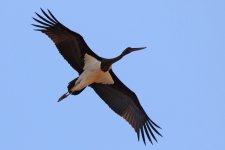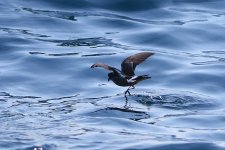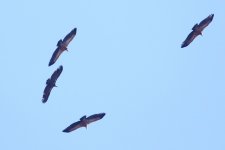The list
Yesterday, the final day, produced just a few new species for the festival including a Ring-billed Gull on one of the pelagics and a Red-breasted Flycatcher in the afternoon in the famous pine hedge. Raptors were less numerous but still lots of nice views of a great variety for everyone. The male 2nd cal yr Pallid Harrier quartered the area between Vale Santo and Cabranosa much of the day too, and many managed to catch up with it for the first time.
This year’s festival attracted over 2,700 visitors from 39 countries, tour groups, many foreign and Portuguese and foreign resident birdwatchers. Of course Cabranosa was very popular, as were the numerous pelagics and many got to see around the wider peninsula, more off the beaten track. Plenty of folk who just wanted to visit more casually did so mainly to the festival’s reception/info/exhibition centre at the stunning historical location of Forte de Beliche, just down the road from Cabo de São Vicente.
The many free to attend guided group outings to diverse locations were a great success – lots of exciting birding and birds and happy birders.
A mention must be made of the untiring and dedicated team whose hard work make the festival happen. Made up of staff from SPEA (Portugal’s Birdlife partner), other nature conservation ONGs, like the Algarve’s Almargem who have worked side by side with SPEA since the first festival and people from the local county council who have been necessary staunch supporters and facilitators.
The birds also did their best to contribute, so worries about the calm and hot weather with very light winds and a disppointing show were dispelled. I think most of the birders got to see at least one or two of the 8 Portuguese rarities. The provisional count of species seen between 4th and 8th October was 157, which included 26 (or 27) different raptors. Here are the birds seen during the festival’s 5 days throughout the peninsula.
Brent Goose
Common Scoter
Red-legged Partridge
Cory's Shearwater
Great Shearwater
Sooty Shearwater
Balearic Shearwater
Wilson´s Storm-petrel
European Storm-petrel
Northern Gannet
Brown Booby
Great Cormorant
European Shag
Cattle Egret
Little Egret
Grey Heron
Black Stork
White Stork
Eurasian Spoonbill
Black-winged Kite
Black Kite
Red Kite
European Honey Buzzard
Egyptian Vulture
Eurasian Griffon Vulture
Rüppell´s Vulture
Short-toed Eagle
Western Marsh Harrier
Hen Harrier
Montagu's Harrier
Pallid Harrier
Eurasian Sparrowhawk
Northern Goshawk
Common Buzzard
Lesser Spotted Eagle
Spanish Imperial Eagle
Booted Eagle
Bonelli's Eagle
Osprey
(Lesser Kestrel)...anyone verify this? It was on the board

Common Kestrel
Merlin
Eurasian Hobby
Eleonora's Falcon
Lanner
Peregrine
Water Rail
Moorhen
Coot
Little Bustard
Oystercatcher
Common Ringed Plover
Kentish Plover
Eurasian Dotterel
Sanderling
Dunlin
Bar-tailed Godwit
Whimbrel
Common Redshank
Common Sandpiper
Turnstone
Pomarine Skua
Parasitic Skua
Great Skua
Mediterranean Gull
Common Black-headed Gull
Audouin's Gull
Ring-billed Gull
Lesser Black-backed Gull
Yellow-legged Gull
Sabine’s Gull
Sandwich Tern
Common Tern
Razorbill
Rock Dove
Stock Dove
Eurasian Collared Dove
European Turtle Dove
Barn Owl
Little Owl
Eurasian Eagle Owl
Long-eared Owl
Short-eared Owl
European Nightjar
Red-necked Nightjar
Eurasian Hoopoe
Common Kingfisher
Eurasian Wryneck
Great Spotted Woodpecker
Thekla’s Lark
Woodlark
Common Skylark
Eurasian Crag-martin
Barn Swallow
Red-rumped Swallow
Common House Martin
Tawny Pipit
Tree Pipit
Meadow Pipit
Yellow Wagtail
Grey Wagtail
White Wagtail
Winter Wren
European Robin
Common Nightingale
Bluethroat
Black Redstart
Common Redstart
Whinchat
Common Stonechat
Northern Wheatear
Blue Rock Thrush
Ring Ouzel
Common Blackbird
Song Thrush
Mistle Thrush
Cetti´s Warbler
Zitting Cisticola
Common Grasshopper Warbler
European Reed Warbler
Melodious Warbler
Blackcap
Garden Warbler
Western Orphean Warbler
Common Whitethroat
Dartford Warbler
Subalpine Warbler
Spectacled Warbler
Sardinian Warbler
Yellow-browed Warbler
Western Bonelli's Warbler
Common Chiffchaff
Iberian Chiffchaff
Willow Warbler
Firecrest
Spotted Flycatcher
Pied Flycatcher
Red-breasted Flycatcher
Great Tit
European Blue Tit
Crested Tit
Iberian Grey Shrike
Azure-winged Magpie
Common Magpie
Western Jackdaw
Common Raven
Red-billed Chough
Common Starling
Spotless Starling
House Sparrow
Common Rock Sparrow
Common Chaffinch
European Serin
European Greenfinch
European Goldfinch
Common Linnet
Ortolan Bunting
Corn Bunting
Common Waxbill
(No swifts or Woodchat Shrike surprised me)







. Thoroughly enjoyed the whole festival

